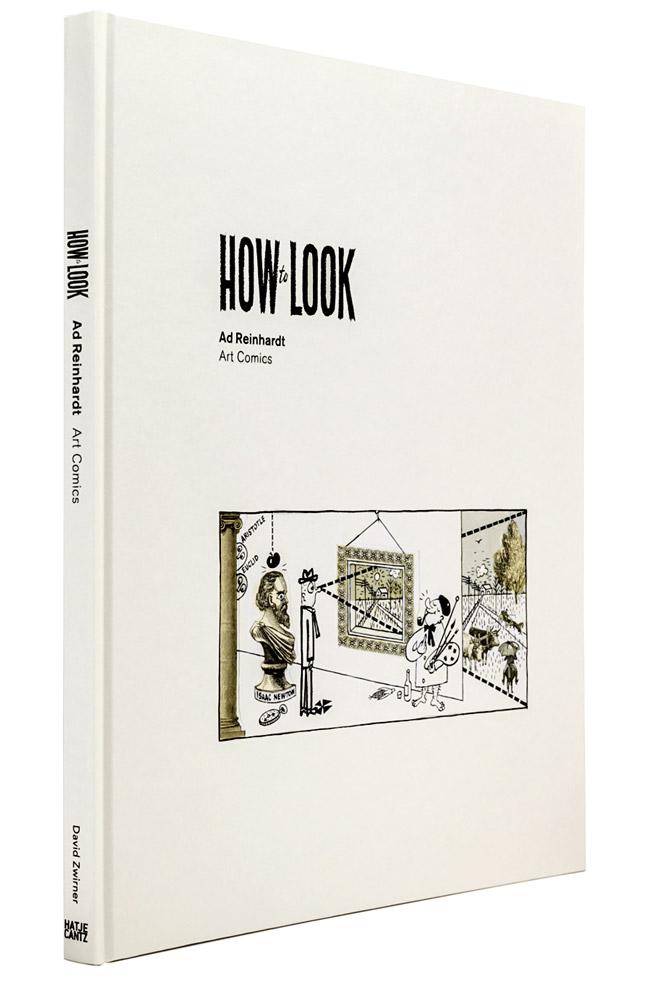Summer is an excellent time to curl up with a beautiful art book, whether in the city or in wilder environs. Here are some newer titles that we recommend.
How to Look: Ad Reinhardt Art Comics, edited by Anna Gray and Kristine Bell, Hatje Cantz/David Zwirner, 92 pp, $44.95.
In curator Robert Storr’s engaging introductory essay for this monograph—made to accompany last fall’s critically acclaimed Ad Reinhardt solo exhibition at David Zwirner in New York—he argues that, while many giants of the Modernist canon moonlighted as freelance cartoonists, Reinhardt was the only one whose ancillary career was “integral rather than incidental” to his artistic accomplishments on the whole. Reinhardt’s laugh-out-loud funny topical caricatures serve as a significant dimension of his practice that is worthy of acknowledgment. As the artist’s comics instruct us on “How to Look,” by lampooning and delivering comeuppance to self-serving art-world parasites, they are acting in zealous defense of Reinhardt’s own resolute faith in the virtue and purity of art. At David Zwirner, 13 of the artist’s austere, transcendent (and mercilessly parodied) Black Paintings occupied their own holy space. No-nonsense hired bodyguards made sure nobody touched the art, while cut-and-paste cartoons hanging on the walls of the adjoining room defended its spiritual sanctity.
Stan Douglas, Steidl, 228 pp, $88.45.
Since the late 1980s, Vancouver artist Stan Douglas has been widely acknowledged as a master of the moving image. Lesser known perhaps is the fact that, alongside his meticulously complex film works, Douglas has consistently produced “stills” that are equally rich with visual and narrative density. This first-ever monograph exclusively devoted to those photographs aims to level that critical view. Essays by Robert Bean and Dieter Roelstraete expand on Douglas’s staging of the liminal zones between time and place, fiction and reality. A lavishly reproduced career-inventory of photo works hammers home the point.
Understanding a Photograph, by John Berger, edited by Geoff Dyer, Aperture, 176 pp, $24.95.
Geoff Dyer is no slouch when it comes to photography. His foray into its history, “The Ongoing Moment,” expounded subtly on photography’s endless openness to interpretation. As editor here, he pays homage to the peerless John Berger by collecting Berger’s various essays on the subject from 1968 to 2005. “The Suit and the Photograph” from 1979 is an exquisite essay on August Sander that begins by wondering what Sander might have said to his sitters to get them to all look at the camera in the same way—an observation that gets to the essence of Sander’s art. Berger too once referred to cameras as “clocks for seeing.” Dyer’s book celebrates the words that come from that seeing.
Garry Winogrand, edited by Leo Rubinfien, Yale University Press, 448 pp, $85.00.
In the 30 years since Garry Winogrand died in 1984, photography has reinvented itself. Part of the Museum of Modern Art’s 1967 “New Documents” exhibition with Diane Arbus and Lee Friedlander, Winogrand’s loose street style has never been bettered. Arbus and Friedlander are now in the pantheon of photography, but Winogrand has languished, in part due to the thousands of rolls of film he left undeveloped at his death. Last year’s survey at the San Francisco Museum of Modern Art should turn this around. As we see here, his photography represents a great, fractured unspooling of 20th-century America.
A Way of Living: The Art of Willem de Kooning, by Judith Zilczer, Phaidon, 288 pp, $100.00.
The Museum of Modern Art in New York’s 2011 Willem de Kooning retrospective was as stunning a painting show as one could imagine—comprehensive, engaging, precise and, ultimately, emotionally exhausting. This book is an unofficial companion piece in its unapologetic commitment to de Kooning as, despite his European origins, one of the greatest American painters. Astonishing as always are de Kooning’s stylistic evolutions from the start of his career to the very end, justifying this book’s amplitude. You don’t really get him unless you get all of him.
Words Not Spent Today Buy Smaller Images Tomorrow: Essays on the Present and Future of Photography, by David Levi Strauss, Aperture, 192 pp, $29.95.
Veteran New York critic David Levi Strauss is the undisputed champion of literary art writing. Here, he brings that lucid narrative voice and erudite critical eye to bear on 21st-century image culture in an array of recent essays that tell a cautionary tale of perceptual flux from Joseph Beuys and 9/11 to the “inconvenient evidence” of Abu Ghraib to the revolutionary anxieties at stake in Zuccotti Park and Tahrir Square.
Showtime: The 50 Most Influential Exhibitions of Contemporary Art, by Jens Hoffmann, Thames and Hudson, 256 pp, $55.00.
It’s appropriate that Hoffmann—who has built his career on remounting historically significant exhibitions—should be the brains behind this definitive list. Though the exhibitions Hoffmann has chosen to highlight have little commonality in their geographies, artworks or even curatorial methodologies, they share a preoccupation with what curation means today, and how curators might take charge of staging experiences with artworks. As Mary Jane Jacob tells Hoffmann in the book, “I believe that an exhibition is now a practice of making. Exhibitions are no longer so much about selecting or organizing, but making.”
This is an article from the Summer 2014 issue of Canadian Art. To read more from this issue, visit its table of contents. To read the entire issue, pick up a copy on newsstands or the App Store until September 14.









